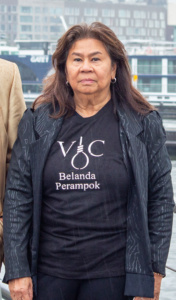Plea by Dida Pattipilohy, on October 13, 2022, the secretary of the foundation

I am a Dutch citizen from Indonesian descent. The Netherlands colonized Indonesia for 350 years. In 1945 the United Nations issued a charter in which they included self-determination as a law of nations. It opened up the way for colonized countries to gain independence from their colonizer. In addition, the United Nations also labeled colonialism a crime against humanity. Completely in accordance with the UN-charter, Indonesia declared its independence on August 17, 1945 as a unitary state under the name Republik Indonesia, headed by a president. This supposedly marked the end of the colonial period. Unfortunately, the Dutch government felt the need to secure its interests in the east, which was accompanied by a lot of violence.
In Indonesia, the ‘bersiap period’ does not exist in our historiography. The term ‘bersiap’ (meaning: to be prepared, to be ready) was used as a slogan by Indonesian independence fighters at the time, to express their readiness to defend themselves against the Netherlands, which did not want to recognize Indonesia’s independence and wanted to recolonize the country. So it was, in effect, a cry of loyalty to the Indonesian independent republic. By using the term to indicate a period of resistance against the Dutch, one ignores that the Indonesians’ struggle for independence had already taken place for a long time. Besides, with the use of the term the impression is made that two equal parties were facing each other. This equalizing of power relations also aims to soften the human rights violations that were committed by the Dutch government.
Indeed, the Netherlands refused to recognize the independency of Indonesia and decided to violently take back the colony. Early 1946 the Dutch invaded Indonesia with a huge military force. Indonesia defended itself against the invasion. Indonesian freedom fighters have resisted the several attempts of the Dutch to occupy the country again. The Netherlands did not have any right to act in Indonesia as authority.
As already mentioned by Marjolein van Pagee and Jeffry Pondaag, the Rijksmuseum has invited a group of people (namely Jeffry Pondaag, Marjolein van Pagee, Ms. Francisca Pattipilohy and myself) to provide input for the exhibition REVOLUSI. During that meeting we firmly stated that the concept of the bersiap does not belong in the exhibition.
According to [Dutch] historian Prof. Dr. Remco Raben, the term ‘bersiap’ should not be interpreted as a fixed term to identify the entire period 1945 – early 1946. However, the latter often happens and that is racist, he says. I quote: “the term ‘Bersiap’ has been created within a colonial context and is used as an essentializing concept to describe the Dutch experience. ‘Bersiap’ is therefore not a neutral term, but one that came into usage based on a Dutch and Dutch-Indies perspective.”
Raben also says: “It is an ethnocentric term that describes a hierarchy within a colonial context and we call that hierarchy racist.” With his interpretation of the use of the term bersiap (which is shared by other Dutch people too), we see that not only Indonesians and the K.U.K.B, but also many Dutch people have difficulty with it. Unfortunately, there is no room for this view in the public debate in the Netherlands on decolonization because the debate is dominated by white Dutch and Dutch Indies people and (descendants of) other ex-warring groups, who [embrace the concept of the bersiap because they] don’t want to be portrayed in a bad light. The general believe is that the occupation of another country was not a human rights violation.
During our meeting with the Rijksmuseum, we advised them not to include the concept of the bersiap in the exhibition, because the use of it contains an insult to Indonesians as group. After all, from the perspective of Indonesians, bersiap is a Dutch fabrication to describe a certain period and to accuse Indonesians. In the eyes of the people using the term, we were ‘bloodthirsty’ and committed crimes against the Dutch, Dutch-Indies people and Maluku because of their collaboration with the Dutch. The Rijksmuseum promised to take our input into account, but it turns out that they ignored it.
In an article in Dutch daily NRC, the Indonesian guest curator (Bonnie Triyana) also spoke out against the use of the term bersiap. However, under pressure from the Dutch Indies association FIN, which reacted angrily and on behalf of the Dutch-Indies community in the Netherlands, demanded that the term bersiap should still be included, the Rijksmuseum reversed its decision.
Why is the Rijksmuseum listening to Dutch-Indies people but not to Indonesian people? The police report of the FIN against Bonnie Triyana is the problem in reverse: a descendant of the pro-colonial group of oppressors, reporting a descendant of the oppressed to the Dutch police.
This clearly illustrates the unequal power relation: a colonial hierarchy that still determines the composition of Dutch society, including the debates that are being held. It is strongly reminiscent of the racism felt by my mother, who once thought she could go swimming at a pool in Batavia as a so-called inlander [native], but was refused entrance because she did not enjoy the Dutch-Indies special status.
By using the term bersiap in Dutch historiography to describe a dark period, Dutch historians are guilty of abusing the term as illustrated by Raben, which only serves to racially frame Indonesians as bloodthirsty people, who behaved criminally and lashed out to kill other humans. As individuals, the Dutch, consciously or not, may sometimes be guilty of racism, but if people like Stevens and Dibbits, who bear responsibility for a correct reflection of history, are also guilty of this, then they are the representation of a racist society in which the voice of the formerly oppressed (Indonesians) is not heard.
It is very important that this is rectified. Thank you.
—
Download as PDF: ![]()
Plea Marjolein van Pagee in ‘bersiap-zaak’ KUKB against Rijksmuseum
